You've found the blog of Chris "The Hoff" Hoffman, former Nintendo Power editor and all-around gamer. Since I don't work for a gaming magazine or site at present, this is where I'll be posting my thoughts on Nintendo, RPGs, Mega Man, Phoenix Wright, and other assorted nonsense…occasionally. You can also find me on Twitter at @ChrisTheHoff.
Don't wanna be here? Send us removal request.
Text
Kicking Acts and Taking Names
Review: Actraiser Renaissance
It's hard to improve upon greatness. Admittedly, the name ActRaiser might not mean a lot to modern gaming audiences, but when it was originally released 30 years ago for the Super NES, it was widely lauded for its unique combination of side-scrolling platforming action and top-down world-building simulation, held together by a captivating world-reviving premise and one of the most impressive, technology-defying soundtracks ever created. Rarely imitated and never duplicated, ActRaiser gained a cult following and for years was revered for its innovation, accessibility, and rewarding gameplay.
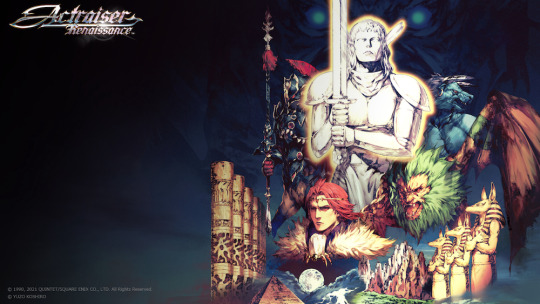
As such, the dev team behind Actraiser Renaissance - a from-the-ground-up remake of ActRaiser - doubtlessly faced an unenviable challenge: making the game relevant to contemporary players while still retaining the elements that made the original such a standout. And make no mistake: Actraiser Renaissance is a remake in the truest sense. Though the game uses the same concepts and components as the original, they are thoroughly rebuilt, remixed, and reassembled in news ways. The core gameplay and structure remain, as do the general maps, level themes, set pieces, enemies, and even the dizzying drop from the heavens - but very little is the same as it once was. Some levels are greatly inspired by the architecture and design ideas of the original, while others expand upon upon their 16-bit predecessors in a number of ways. In other regards, Renaissance feels like a whole new game - despite looking familiar, for example, bosses use completely different tactics and require entirely new reprisals.
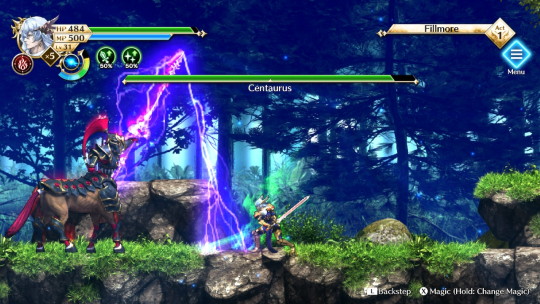
What's important, though, is that the sword-swinging fantasy action is still satisfying and fun. It's simple enough to jump into an action stage and start slicing away at enemy beasts, now with combat options that have grown considerably since the original game. Movement is more fluid and responsive, and your repertoire now includes a rising sword strike and diving slash, along with an evasive dodge that's essential for survival in the Normal and Hard difficulty settings. Enemies also now drop crystals that increase your power and boost your chances of survival, plus you can now switch magic abilities during action stages instead of being stuck with whatever one you've chosen beforehand. The reimagined levels are diverse and well designed, with multiple routes and permanent stat boosts hidden off the beaten path to encourage exploration and replayability.
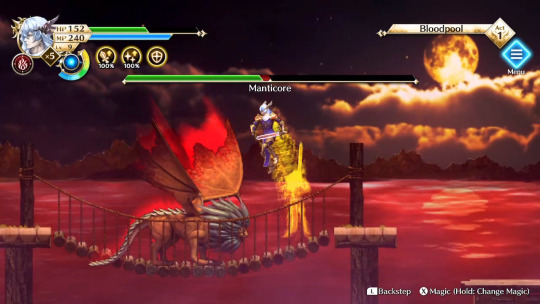
While the action stages don't stray too far from the original 16-bit concepts, the simulation segments have expanded considerably - most notably with the inclusion of new tower defense/real-time strategy segments. In the vintage game, the simulation segments were light and breezy affairs; you'd guide the direction of village construction, shoot enemies as an angel, solve a few problems with elemental miracles, and have a new civilization ready to go in 30 minutes or so. Not the case in Renaissance - you can expect each region's simulation scene to take a couple of hours, much of which is spent placing and upgrading three types of defensive constructs to protect against enemy hordes that attack at mostly predetermined points in the civilization's growth.
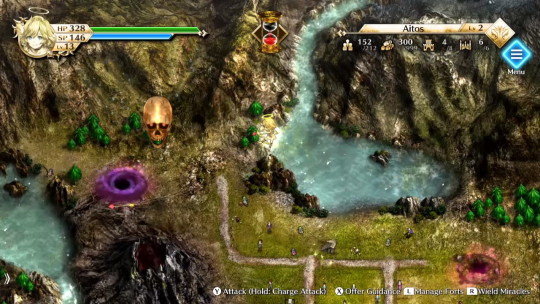
Unfortunately, these RTS sections feel half-baked; critically, you don't know where the enemies will be coming from in advance, and you can't move your emplacements during enemy assaults, so it comes down to luck or playing, failing, then retrying after repositioning your defenses - but even then, it can be hard to determine enemies weaknesses (which dilutes the strategy), and there are often arbitrary placement restrictions that make these segments needlessly convoluted.
More successfully, the simulation scenes also introduce new hero characters. They can be guided much more directly and are essential for stopping the enemy onslaught, but perhaps more importantly, they are integral to the game's more fleshed-out story and inject an appreciated dose of humanity that was absent in the original ActRaiser. Though these heroes are initially specific to each region, they can eventually be summoned to participate in other areas' RTS battles should the need arise (and it will). And it isn't just these new heroes that add to the game's personality. Tanzra's minions - the enemy bosses - have become full-fledged characters as well.

The game has changed in numerous other areas too. New, brief action stages occur when you seal monster lairs, adding variety to the now-lengthy simulation segments. And diehard fans will notice countless minor adjustments to the story beats and play mechanics, with some aspects more transparent and others more obtuse: for example, your performance in action stages no longer dictates the maximum size of your community, experience is now gained by completing quests rather than simply based on total population, and accomplishing certain tasks tends to reward you with EXP boosts for the hero characters rather than key items like in the original game. (In fact, the opportunity to use and share "offerings" is overall quite diminished.) But the best change, without a doubt, is an entirely new area at the end of the game after the credits roll, which includes both a new action stage and simulation map, and comes complete with a new boss.
Aesthetically, Actraiser Renaissance is pleasing to look at. The action-stage visuals are solid if not especially spectacular, but the game truly shines during the simulation scenes, which now boast a level of detail never previously imagined. The overhead maps now actually resemble living, breathing, thriving communities rather than the comparatively primitive approximations from the original.
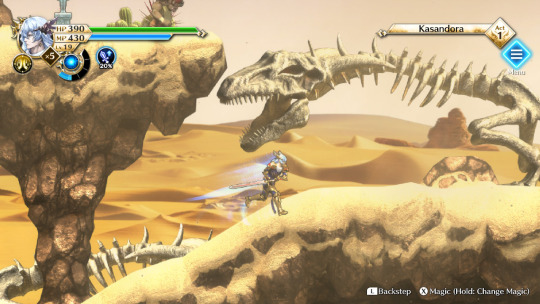
And the music, thankfully, absolutely soars. The awesome symphonic soundtrack by Yuzo Koshiro was one of the standout features of the 16-bit game, and it continues to impress in Renaissance. All the classic tunes have been updated and remixed for this version of the game, and numerous new tunes have been added. Better yet, you can choose to play with either the original 16-bit sounds or the modernized versions - and yes, even the new tracks are available in both styles. If you've never played ActRaiser before, this game is worth trying for the soundtrack alone.
Ultimately, Actraiser Renaissance is an experience that's deeper than the original, offering modern accoutrements, more complexity, and longer playtime in exchange for some of the charm and pick-up-and-play simplicity of the vintage game. It isn't necessarily better than its 16-bit predecessor, nor is this game a replacement for it. But that's OK. Instead, Renaissance stands beside the original as a welcome re-interpretation of a true legend of the Super NES era, and as a fine way to celebrate this genre-blending classic, particularly if you don't have an SNES or Wii Virtual Console version handy.
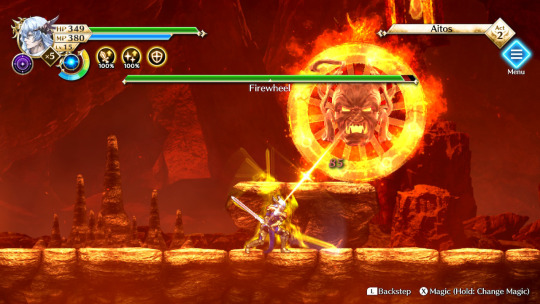
12 notes
·
View notes
Note
Incredibly amazing games that are super-expensive? Also, where can I find a database of the contents of every Nintendo Power magazine? For example, if I wanted to have a complete Ocarina of Time issue, how do I make sure I have all the inserts, stickers, posters, ads, ect?
Hmmm, I’m guessing that first comment was made in reference to my Snatcher 25th anniversary post? It’s funny, I think some of the time games that are super rare gain legendary status just because of how unobtainable they are and not because they’re really *that* good. Like, a game may be a solid 7 or 8, but suddenly becomes the “best game ever” because it’s just so expensive/unavailable.... But I can safely say that is not the case with Snatcher, IMO. Obviously it shows its age after 25 years in some ways, but the writing and voice acting are still second to none, and I feel so lucky that I took a chance on getting this game that I knew nothing about at the time.
Uhhh... What was the actual question? Oh, Nintendo Power database? Hmm, I don’t know if there’s anything like that online, but we certainly kept records of most of that. Mostly it tracked what games were covered in every issue, and we tried to include a listing of all the extras/inserts for every issue, but I can’t guarantee it was 100% accurate, and I’m not sure if it covered anything beyond when Future took over publishing in 2007. Regardless, I don’t think that was ever made public. Surely there must be a fan-made database, right!?
4 notes
·
View notes
Note
Just wanted to say thanks for the many excellent articles in Nintendo Power. Your (and the other staff writers') approach to (gaming) journalism was influential in how I wrote guides for GameFaqs and work throughout my academic career, through my Master's. What're you doing now?
Thanks for the kind words! I don’t know if I’d call my work on Nintendo Power “journalism” necessarily (we thought of it more as entertainment writing), but if we were able to help with your writing endeavors then that’s awesome! Congrats on the degree!
These days I’m working for a certain indie game studio, handling all of their external writing and communications (eShop descriptions, website updates, trailer text, press releases, social media posts, etc.), and while I consider Power Pros podcast to officially be on hiatus as of June 2020 (after reaching 200 shows), I still record new “Bonus Episodes” whenever I get a chance and I have a topic I’m eager to discuss.
And of course, still playing as many games as I can! I still put in at least 30 minutes of Animal Crossing: New Horizons every day, even a year after launch, plus whatever else I can manage!
4 notes
·
View notes
Note
Hey, Hoffman, I just have one question. Is Chris Slate still in space? If so, do you know if he's ever seen anything peculiar up there, such as a giant ship shaped like Luigi's brother's head, or a moon with a face on it?
Slate safely returned to Earth about, oh, four years after being launched into space. He now hosts the official Nintendo Power Podcast but nonetheless has to deal with numerous interstellar oddities such as spaceships full of Pikmin.
3 notes
·
View notes
Note
Hey man, what happened? No posts in over a year. Worried about you. Doing okay?
Oh, man! Yes, it’s true, it seems I neglected my Tumblr for over a year, and all my writing has been related to work. I appreciate the concern and apologize for disappearing. Hopefully I can write more stuff for fun this year! Everything’s fine though. We’re all fine here, now. How are you?
6 notes
·
View notes
Text
Better with Rage
Review: Streets of Rage 4
Today marks the one-year anniversary of the release of Streets of Rage 4, but in many ways, the game feels like it could have come out decades ago. I mean that in the best way possible; Streets of Rage 4 is right at home with the very best beat-'em-ups from years gone by, when the genre was in its heyday and series like Final Fight, Double Dragon, and the vintage Streets of Rage titles were unstoppable on consoles and arcades. The teams at Lizardcube, Guard Crush Games, and Dotemu have recaptured that hard-hitting, visceral magic with precision and impact, and delivered a love letter to beat-'em-up fans that keeps me smiling and replaying even a year after launch.

To me, the joy of a good beat-'em-up comes from two primary sources: satisfying action and plentiful variety. Like its Sega-created predecessors, Streets of Rage 4 nails it in the first department with responsive controls, generous collision detection, and an excellent sense of reaction from enemies as you lay into them (or from your character as they pummel you), with just the right amount of stagger and the ability to smoothly chain moves into one another. Grabs and auto-combos are as intuitive as ever, but unlike the classic Streets of Rage games, the engine accounts for juggles and rebound attacks, opening up even more combo possibilities, while special moves now offer the opportunity to regenerate health, making them a more viable, user-friendly combat option.

And when it comes to variety, the game is likewise second to none. Four playable characters are available from the beginning: series mainstays Axel Stone and Blaze Fielding, who both offer solid all-around capabilities; Cherry Hunter, who brings speed and acrobatic flair; and Floyd Iraia, the slow but sturdy powerhouse. While Floyd is my favorite (I especially love the wild look in his eyes as he grabs two enemies and smashes them together), each character is fun in their own way, and the initial four are joined by a number of unlockables, including Adam Hunter (finally playable again after the first SOR!) and almost (almost!) every playable character from past Streets of Rage games in all their pixel-art glory.
But character variety is only the beginning; moves, enemies, bosses, weapons, obstacles, environments — Streets of Rage 4 delivers across the board. While the game starts in the familiar city streets (complete with the good ol' Pine Pot diner), you'll soon find yourself in a police station, on a boat (an SOR standard!), in a restaurant kitchen, atop a speeding train, in an art gallery, at a concert, and more, with each level packed with both new and returning foes. No level overstays its welcome, ensuring that the game stays constantly fresh, fun, and interesting across the two to three hours it takes to complete the game's story mode. There are even hidden throwbacks to classic SOR series moments.

Speaking of classic Streets of Rage, I especially enjoyed how the game's story ties directly into the original trilogy. Story has never been a particularly important part of beat-'em-ups, but what's here sets the stage spectacularly and shows a great respect for the games that have come before, with numerous fun connections to past series entries.
The presentation is excellent as well. Now in hand-drawn HD, the graphics are every bit as charming as their old-school counterparts, with vibrant colors and impressive yet often subtle lighting effects. And, of course, Streets of Rage wouldn't be Streets of Rage without rockin', adrenaline-pumping music. Though it may not reach the nostalgic heights of SOR 1 or 2, and my favorite tracks are Yuzo Koshiro's retro-flavored tunes, SOR4 delivers a fantastic soundtrack that continues the series trend of offering cutting edge and slightly experimental sounds through a combination of energetic rhythms, pounding beats, and modern dance and techno influences.

It all comes together in what I consider to be very close to beat-'em-up perfection — taking the classic formula I loved from the Sega Genesis era and modernizing it with four-player action, online gameplay, smoother play mechanics, and a gorgeous coat of visual polish, all while honoring the original games that made this one possible. Thanks to its pick-up-and-play nature and a variety of difficulty options, it's a game that I keep coming back to again and again, even a year after launch; it's easily my favorite video game of 2020 (and of course, I had to get the collector’s edition!).
And perhaps the best part is that it's not over yet. With DLC on the way, the fight continues with new environments, new playable characters, new weapons, new music, and the new Mr. X Nightmare mode. And I absolutely cannot wait.

6 notes
·
View notes
Text
25 Years of Snatcher

An airborne toxin that annihilates half the world's population followed by an invasion of killer robots indistinguishable from actual humans would, in real life, present a pretty rough time for mankind. In the fiction of Hideo Kojima's classic video game Snatcher, however, this scenario provides hours upon hours of fun, danger, and intrigue for the players fortunate enough to have experienced its 16-bit cyberpunk thrills.
Released in North America approximately 25 years ago, exclusively on Sega CD, Snatcher is currently celebrating a landmark anniversary in the West. Yet, for most of those 25 years, the game has flown under the radar, unplayed by most and underappreciated by many due to the Sega CD's minimal audience and the subsequent limited availability of the game. Those who played it, though, discovered that Snatcher was much more than just a point-and-click graphic/text adventure; it was one that made you think, made you feel, and, at the time of its release, altered perceptions of what the video game medium made possible.
At the heart of Snatcher was its incredible world-building. Set in the city of Neo Kobe, Japan in 2047, Snatcher presented a multicultural, neon-drenched world of heroes, villains, and high technology. Certainly, it was heavily inspired by the film Blade Runner, but Snatcher wasn't merely a film homage mixed with '80s Japan. Thanks to the in-game computer database, JORDAN, players could delve into the history of Neo Kobe, learn about the Catastrophe (the release of the aforementioned population-decimating toxin), find out about the era's government, infrastructure, sports, entertainment, and more — you could even get info on ancillary characters that were little more than names in the manual. The handful of in-game environments provided a solid foundation of what the game's world was all about, but by including intricate details about all aspects of society, Snatcher gave the impression of a sprawling universe that went far beyond the confines of the game.

That universe, naturally, would be nothing were it not filled with interesting characters and events. Fortunately, the plot — about the Snatchers ("bio-roids" that killed and copied their human victims) covertly invading Neo Kobe — was a more-than-compelling hook. The JUNKER (Japanese Undercover Neuro-Kinetic Elimination Ranger) agency was all that stood between these robots and the evident destruction of humanity, and amnesiac new recruit Gillian Seed was the JUNKERs' last hope. It was easy to grow attached to the highly skilled yet somewhat goofy protagonist, and his costars — including diminutive robotic assistant Metal Gear Mk. II, enigmatic bounty hunter Random Hajile, grumpy JUNKER engineer Harry Benson, and the suspicious informant known as Napoleon — were no less appealing. Players sat on the edge of their seats when the characters fell into peril, cheered when they overcame the odds, felt sad when their relationships soured, and perhaps shed a tear or two when they made the ultimate sacrifice.

It certainly helped that all of the characters came to life by an incredibly talented voice cast. Back in 1994, voice acting was barely an afterthought in most console games (if they had voice acting at all), and outside of dedicated localization companies like Working Designs, video game voice acting tended to be embarrassing at best. Snatcher, however, was the exception, and the likes of Jeff Lupetin, Susan Mele, Lucy Childs, and Ray Van Steen gave the cast personality and emotions that few games could match, and their work holds up with the best of them even 25 years later.
Additionally, Snatcher helped push interactive storytelling forward with a legitimately mature presentation. Ironically, Snatcher was rated T for Teen (despite having scenes such as a character with his blood-splattered head twisted off and sitting in his lap), but it could be considered much more mature than other M-rated games of its day. There weren't too many console games out there that dealt seriously with the death of a parent or a struggling marriage, and the underlying theme of overpowering humanity through fear and mistrust is perhaps more poignant now than ever. Furthermore, the methodically paced, menu-driven exploration broken up by brief action/shooting segments made the game feel different from the usual kid-friendly, nonstop-action fare of the era.

That's not to say Snatcher was overly somber and serious; quite the opposite, in fact. Perhaps the biggest reason for its enduring appeal is how seemingly effortlessly it managed to juggle action, drama, and comedy in its script, certainly thanks in no small part to the wonderfully entertaining translation/localization by Jeremy Blaustein and company. Despite being a sci-fi thriller, Snatcher gave ample screen time to oft-humorous interactions between Gillian and Metal Gear (as well as between other characters), providing a wit and tone that few games could match, and offering the perfect counterbalance to the impending humanity-ending crisis.

Other noteworthy aspects included a fantastic soundtrack and numerous secret scenes that made the game far deeper and more replayable than other titles in its genre. Unfortunately, Konami has never attempted to re-release the North American version of Snatcher (despite it making appearances on more popular systems like the PlayStation 1 in Japan), relegating this pre-Metal Gear Solid "Hideo game" to cult-hit status at best.
Nonetheless, despite never being the biggest game, the most critically acclaimed, or the most popular, even a quarter-century after its North American release, Snatcher remains a masterpiece in interactive entertainment, and is arguably one of the most entertaining and groundbreaking video games ever published for a home video game system.
[For more on Snatcher, see my 20-year-anniversary interviews with translators Jeremy Blaustein and Scott T. Hards, as well as Gillian Seed's voice actor Jeff Lupetin.]
29 notes
·
View notes
Text
Best of E3 2019 ~ Belated Edition
E3 2019 - held June 11-13, 2019 in Los Angeles, CA - is already ancient history, but that's not stopping me from from giving some belated impressions of what was on display or announced at this year's show. Better late than never, right? Without further delay, here are my top 10 Nintendo-related highlights from the recent gaming extravaganza.

10. Heroland This is a weird game: you act as a guide for a group of would-be heroes in an adventurer-focused theme park. The graphics are rather simple, and your party members more or less fight on their own, with you having only limited control over their actions. However, the story and writing in this XSEED-published title are hilarious and seem like they'll compensate for any gameplay shortcomings.

9. Pokémon Sword & Pokémon Shield The demo for Pokémon Sword & Shield was pretty limited and didn't tell me much about the game I wasn't already expecting, but the big news for me was Yamper, the corgi Pokémon. How can you not love a corgi Pokémon?! If I hadn't been sold on the game before, well, I certainly am now.
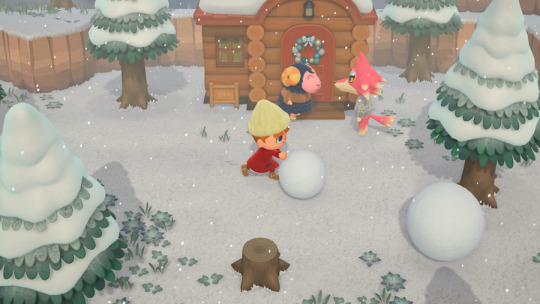
8. Animal Crossing: New Horizons Yes, it's too bad it got delayed, and yes, I wish it had been playable, but it's great to see that Animal Crossing: New Horizons is coming along well and including features like crafting and a bigger focus on multiplayer. It should be great!
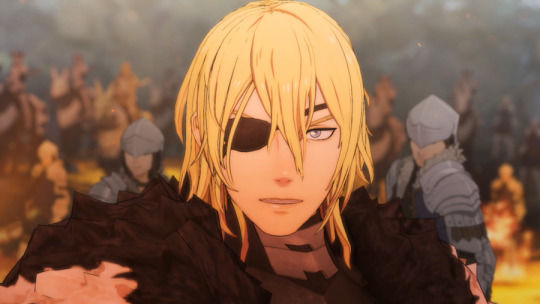
7. Fire Emblem: Three Houses In the space of one trailer, Fire Emblem: Three Houses made a tonal shift from Harry Potter Year 1 to Harry Potter Year 7. I can't wait to see how it all plays out when the game hits in July.
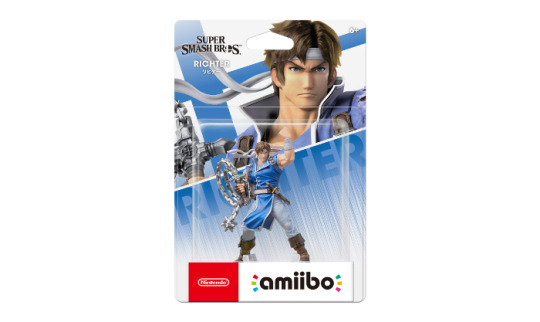
6. amiibo! I'm always excited for more amiibo, but even more so when it involves favorite franchises like Zelda and Castlevania. It was great to finally get a look at characters like Richter Belmont, Incineroar, Dark Samus, and Chrom, and I could always use a new version of Link!

5. Astral Chain This is another one that I wish had been playable on the show floor, but I'm very excited for it nonetheless. It looks to have all the great action that we've come to expect from Platinum Games, along with a lot of exploration and investigation and an extremely compelling cyberpunk world.

4. Luigi's Mansion 3 I expected Luigi's Mansion 3 to be good, but the demo surpassed my expectations. The demo was dense and full of cool things to discover in every room, and I especially love the ability to slam ghosts into each other. Visually it's spectacular as well. And the E3 booth, which was practically a Luigi's Mansion 3 theme park attraction, was one of the best reasons to actually go to the show.
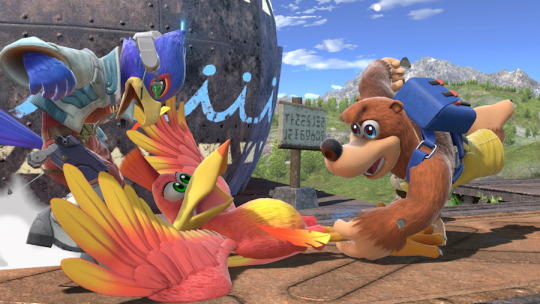
3. Hero & Banjo in Super Smash Bros. Ultimate Though neither Dragon Quest nor Banjo-Kazooie are personal top-tier favorites of mind, I'd be hard pressed to think of two more deserving characters to be added to the Smash Bros. roster. I've always wanted to smack my friends with a bird.

2. The Legend of Zelda: Link's Awakening The original Link's Awakening is in my top 25 games of all time, so I had high expectations for this one, and the E3 demo met all of them. It's a game I've loved for 25 years, with a gorgeous new "diorama-come-to-life" look, enhanced controls, and just enough newness for the game to feel fresh while still retaining all charm and familiarity of the original. The actual handcrafted dioramas in Nintendo's booth were amazing too, and sign me up for the special edition that includes an artbook!

1. The Legend of Zelda: BOTW Sequel Predictable, yes, but how can I not pick the Switch follow-up to The Legend of Zelda: Breath of the Wild? As a landmark entry in one of my favorite series, I can't wait to see where Nintendo takes the series from here. Was that really Ganondorf's body? Will Zelda be playable? How will the formula change!? I can't wait to find out.
BONUS: Top 3 Non-Nintendo-Related Highlights of E3 2019

3. Legend of Heroes: Trails of Cold Steel III Despite the publisher change from XSEED Games to NIS America, Trails of Cold Steel III doesn't seem to have lost a step. It's about as classically inspired and traditional as you can get when it comes to RPGs on console these days, which is perfect for old-school enthusiasts like myself.
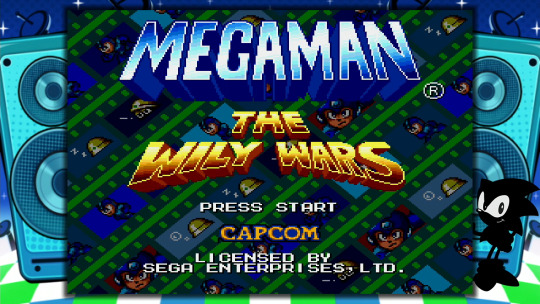
2. Sega Genesis Mini Speaking of old-school, I was thrilled to go hands-on with the Sega Genesis Mini and finally play an English version of Mega Man: The Wily Wars. I'm looking forward to a lot of games on this piece of hardware, but none more than that. It's a dream come true after 25 years!

1. TMNT arcade machine from Arcade 1up Likewise, I was very impressed by the scaled-down four-player Teenage Mutant Ninja Turtles arcade unit from Arcade 1up. Featuring both the first and second TMNT coin-ops, these are some of my favorite arcade games ever released, and they've never been available at home in arcade-perfect form before (although the Xbox 360 port was very close). Where am I going to keep an arcade machine, even a scaled-down one? I don't know, but I guess I'll find out!
6 notes
·
View notes
Text
Familiar but Foreign: A Taste of Japan
When traveling in a foreign country, I always make it a point to try to eat foods specific to the locale. On my recent trip to Japan, that meant a lot of things commonly associated with the region: sushi, curry, ramen, and various noodle and rice dishes. It also meant eating things I'd normally never touch with a ten-foot anything, like chilled monkfish liver and assorted mystery pickles. However, it also meant paying a visit to a few popular American fast-food eateries and experiencing for myself just how their menus differed from their stateside counterparts. Here's what I encountered.

My previous trips to Japanese McDonalds had yielded treats such as the Bacon-Potato Pie, the McFrank Burger, and the McDelicious Soup (which lead to much hilarity when my friend misunderstood it as Dick Delicious Soup, but that's another story). This time, though, their focus was on the American Deluxe menu, most notably the Texas Burger and the Idaho Burger. The Texas Burger was a beef patty topped with cheddar cheese, bacon, crispy onion straws, and BBQ sauce; the Idaho Burger was topped with a typical McDonald's breakfast hash browns, plus bacon, onion, cheddar sauce, and garlic-and-pepper sauce. Sadly, these burgers were already marked as sold out at locations near me, and I had to settle for the breakfast variations instead, specifically the Texas Muffin, which was a Sausage McMuffin with the addition of crispy onion straws and BBQ sauce. The flavors worked together surprisingly well, and though it sounds a bit weird, I would absolutely get it were it added to the American menu.

I stopped at McDonalds a couple more times on my trip; the American Deluxe special menu was replaced with the McCroquette Burger, which, indeed, featured a patty basically made out of deep-fried fried mashed potatoes and topped with a cheese fondue sauce, mayo, and cabbage - and was offered as a breakfast item. It was unusual, but not bad. My other McDonalds breakfast stop allowed me to sample the Chicken Crisp Muffin (which was a regular menu item, I believe, rather than a limited-time offer). It amounted to basically a very large Chicken McNugget served on an English muffin with lettuce and mayo. I think I'll pass on that one next time.

I also paid a visit to Wendy's while I was in Japan - or "Wendy's First Kitchen" as it was called. Their limited-time specialty menu, unfortunately, was focused on mushrooms, which I wasn't going to subject myself to if I didn't to. However, they had many things on their regular menu that aren't available in the USA. I chose to get the Bacon, Egg and Cheese Burger, which was exactly what it sounded like - a cheeseburger topped with bacon (which, in Japan, was generally less crispy and more hamlike than American bacon), a fried egg, and some mystery sauce. I got it in a combo with cheddar fries, which were merely fries sprinkled with a mildly cheesy-flavored powder; they weren't anything special, but apparently there was some promo going on with the cheddar fries that resulted in them coming in a Zoids-themed bag and included a free set of Zoids stickers. My drink, meanwhile, was an "iced cocoa" - better known in America as chocolate milk. My Wendy's First Kitchen experience was OK but nothing special.

I had to stop at KFC as well. Despite the fact that KFC is something of a Japanese cultural icon and is often recognized for being significantly better than its US counterpart, I'd never been to a Japanese KFC before. I chose to get the Wa-Fu Chicken Cutlet Combo. This consisted of the Wa-Fu Chicken Cutlet (a breaded chicken patty doused in a sweet sauce, topped with mayo and lettuce and served on a plain bun), as well as all the combo accoutrements: a rather tasty piece of boneless chicken, spiral-cut potatoes, a drink, and a mini custard pie. The sandwich was fine, although I was hoping for something on the spicier side, and overall the meal was pretty decent for KFC. It was probably a tad juicier and more flavorful than American KFC food, but certainly not by a lot.

Naturally, I needed a lot of energy during my Japan visit, and that meant one thing: I needed a lot of caffeine. Usually this meant canned coffee out of vending machines (yes, it's served warm), but occasionally it meant a trip to a Japanese Starbucks, which was offering two unique seasonal beverages during my visit. The first was called the White Chocolate Snow, which I would best describe as tasting like a liquified sugar cookie topped with frosting and then buried in more sugar. It is very likely the sweetest thing I have ever tasted. According to a Japanese-speaking acquaintance I met over there, it was indeed a coffee-based drink, but even if that was true I couldn't taste anything beyond sugary sweetness. The other seasonal drink was a Pistachio Christmas Tree latte, which also didn't taste much like coffee, but did successfully taste like pistachios, at least, and was topped with raspberry syrup which helped complement and bring out the flavors. I think this one could definitely find a receptive audience in North America.
Strange? Maybe. Tasty? Arguably. Different? Absolutely. You never know quite what you're going to get when you give familiar fast food favorites an international twist.
5 notes
·
View notes
Text
Classic Confrontation
I am, for good reason, known as a Nintendo guy. But it wasn't always that way. Even though I grew up on the NES and Super NES, I was more of a PlayStation guy than an N64 guy, and I worked at multiplatform publications before I joined NP. So it's not a stretch to say that I know a thing or two about the games that defined the original PlayStation - and I don’t think the 20 titles on the PlayStation Classic are quite it. Sure, some are all-time greats, but a lot of the games were mere afterthoughts back in their day, and many of the system's most beloved titles are missing in action. Since everyone's giving their opinions on it, here are the 20 games I'd choose as a more reasonable snapshot of what the PS1 was all about while still being well-rounded and fairly fun to play even today. (For the record, my personal list would include a lot more Lunar, Suikoden, and Mega Man, but I digress.)

Ace Combat 2 Castlevania: Symphony of the Night Crash Bandicoot Final Fantasy VII* Gran Turismo Mega Man Legends Metal Gear Solid* Oddworld: Abe's Odyssey* Parappa the Rapper R4: Ridge Racer Type 4* Resident Evil* Spyro the Dragon Super Puzzle Fighter II Turbo* Syphon Filter* Tekken 3* Tomb Raider Tony Hawk's Pro Skater 2 Twisted Metal 2 Wild Arms* Wipeout
*Indicates a game included on the actual PlayStation Classic
8 notes
·
View notes
Text
A Wiener Is You

What happens if you combine the NES game Pro Wrestling with one of America's favorite foods? It's a question that probably shouldn't be considered, yet one I've been attempting to answer for the past year. The result is "A Wiener Is You" — a conceptual hot dog stand serving delicious gourmet hot dogs inspired by the characters of Pro Wrestling. After much culinary contemplation and edible experimentation, I arrived at the following menu influenced by this groundbreaking 8-bit classic.

The Fighter Hayabusa A hot dog topped with bacon crumbles and pineapple salsa, drizzled with a creamy teriyaki sauce. Though delicious, this hot dog is always defeated first.

The Star Man A mysterious and slightly spicy hot dog, this one is topped with queso sauce, avocado slices, jalapenos, red onion, and crushed blue corn chips.

The Kin Corn Karndog A traditional homemade, hand-dipped corn dog. Mongolian mustard and Korean barbecue sauce are served on the side as condiments.

The Giant Panther As large and meaty as the character that inspired it, the Giant Panther is a jumbo beef frank topped with strips of bacon, sliced cheddar cheese, smokey barbecue sauce, and crispy fried onion straws.

The Amazon Lean, mean, and with a bit of green, this worldly dog is a linguica sausage topped with pork chili verde, shredded pepper-jack cheese, green onion, and sriracha sauce — with a fork stuck in it for good measure. Make short work of it with a Piranha Bite.

King Slender's Slender Splendor Simple but tasty, King Slender's Slender Splendor is a foot-long hot dog topped with mustard and pickle spears. Onion optional. A classic!

The Great Puma The boss of all hot dogs! Featuring a bacon-wrapped hot dog doused in chili, then covered with shredded cheddar cheese, sweet onion, diced pickle, and spicy brown mustard, all served in a toasted bun, this hot dog combines several other hot dogs' signature flavors into one nearly unbeatable championship-level meal.
So there you have it: seven hot dogs based on seven of the greatest video-game grapplers of all time. Look for the "A Weiner Is You" hot dog stand somewhere near you as soon as Nintendo announces a Pro Wrestling sequel or Hades freezes over (whichever comes second).
166 notes
·
View notes
Note
Hey Chris! I’m sure you have heard of Nintendo Force magazine. Have you ever considered writing for them? I’ve been listening to your Power Pros podcast since the beginning with Chris Slate. I’m a huge fan of your work! 38 year old father of three who has been a Nintendo nerd since 1985.
Thanks for the kind words and for listening to Power Pros! I’m certainly familiar with Nintendo Force, and I know several of the editors there. I forget if we’ve ever specifically talked about me writing anything for them, but I get the feeling that the door is always open if I could fit it into my schedule.
4 notes
·
View notes
Text
Review: Capcom Beat 'Em Up Bundle
Like a battle-hardened vigilante dishing out justice to street thugs, Capcom Beat 'Em Up Bundle has burst onto Nintendo Switch (as well as PS4, Xbox One, and PC), delivering hit after hit after bone-shattering hit of old-school co-op arcade brawling. Pixel-perfect ports of seven knuckle-busting coin-ops — Final Fight, The King of Dragons, Knights of the Round, Captain Commando, Warriors of Fate, Armored Warriors, and Battle Circuit — are included, ensuring plenty of hard-hitting multiplayer fun for the $20 price tag.

Personally, Final Fight is all that's necessary to get me excited. Despite being available on home systems dating back to the Super NES era, this is the first time an arcade-exact version of the game has been released on Nintendo hardware without any compromises. That means three distinct playable characters, all six levels, two-player co-op, and every little detail that allowed Final Fight to set the standard for the beat-'em-up genre. The appeal goes beyond the timeless 16-bit visuals and rocking soundtrack; Final Fight is also packed with variety and personality — for instance, instead of simply palette-swapping enemies, the game expands its rogue's gallery by giving foes new names and faces in addition to new colors.
Final Fight also has a surprising amount of nuance for such a simple genre - specifically, the ability to combo punches into throws, which, when used effectively, is great for clearing out crowds and turning offense into defense. And, most importantly, the game just feels right — the range of your attacks, the simple AI, the way bad guys react to your blows and you to theirs. Plus, it's just plain fun. Who doesn't love eating barbecue out of a trash can, smashing up a bad guy's car, or piledriving a lowlife kidnapper into the concrete? It all adds up to a game that's still as fun now as when it was first released nearly 30 years ago.

The other six games in the collection might not be as groundbreaking as Final Fight, but they're equally as action packed and offer even more variety in terms of settings and gameplay. Given its emphasis on ranged attacks over up-close-and-personal fisticuffs (characters send out an energy wave when they strike), The King of Dragons feels like a hybrid between a beat-'em-up and a more traditional action game than a straight beat-'em-up, but it nonetheless stands out for its high fantasy setting, diverse character classes, and RPG-style leveling up. Knights of the Round also offers a fantasy setting, three-player gameplay, and RPG-style leveling up, though it feels much more like a traditional hack-and-slash game. The difficulty feels somewhat cheap — this was clearly a full-on quarter-muncher — and the lack of throws makes the moveset limited, but at least it adds the ability to fight on horseback. Things take a turn for the bizarre with Captain Commando, which offers four-player action in some of the most ridiculous settings you'll even encounter in a beat-'em-up, including an aquarium, a circus, and a natural history museum. The character selection is equally insane, with offerings including an alien mummy and a genius baby driving a mech suit (who can, happily, perform a jumping piledriver).

The three remaining titles have never been released outside of arcades in North America, and even in coin-op form, they were fairly obscure, making their inclusion here all the more appealing. Warriors of Fate features a pseudo-historical Japanese setting and on-horseback action (think Dynasty Warriors as a 2D brawler), while Armored Warriors is a sci-fi mech-based beat-'em-up that enables you to power-up with new abilities by acquiring the parts of your fallen foes; it also features ranged sub-weapons that add a unique twist. Though I haven't spent nearly as much time with Armored Warriors as I'd like, it's quickly turning into a personal favorite. Battle Circuit, meanwhile, is the most modern game in the group (adding unlockable abilities and Street Fighter-style special moves to the mix), and it feels like a direct follow up to Captain Commando, due not only to its crazy character designs, but also its over-the-top, four-player, futuristic-superhero action.
Despite the repatition inherent in the genre, all seven titles in the collection offer undeniable (if rather simplistic) fun, plus there are plenty of extras, including both Japanese and international versions of the games, extensive art galleries, customizable controls with optional turbo-fire, save-game functionality, and multiple wallpaper settings. Strangely, there are no visual options such as graphical smoothing or aspect-ratio adjustment, but the default settings, at least for me, do the job.

The online functionality, on the other hand, is a mixed bag at best, at least on Nintendo Switch. When I played Captain Commando and Knights of the Round in four- and three-player modes respectively, the action slowed to one-frame-per-second crawl, rendering the games next to unplayable. Final Fight and the two-player version of Captain Commando ran much smoother, but even then, there were problems, such as the inability to create private or friends-only rooms, resulting in random players jumping into my attempts to play co-op with pals. And equally problematic is the spectator mode, though it's a great inclusion in theory. Once a friend and I managed to start playing together, spectators with bad connections actually caused our play session to crash. It remains to be seen if any of these problems can be smoothed out over time; ideally, Capcom will issue a patch, but I'm not holding my breath.
Though the iffy online component brings down an otherwise excellent package — the best way to play these games is with other players, after all — this is still a fine collection for nostalgic gamers who miss the days of yore, especially if they have a nearby friend for local co-op. Overall, I give Capcom Beat 'Em Up Collection a dropkick, three straight punches, and an uppercut topped off with a flying piledriver.
12 notes
·
View notes
Text
Broken Blades: Revisiting Xenoblade Chronicles 2
It took me more than six months and 200 hours of playtime, but at long last I defeated Malus, reached Elysium, and saved the world of Alrest in Xenoblade Chronicles 2. I loved many aspects of this RPG — exploring the vast, sprawling landscapes; watching the relationships between characters unfold; interacting with various Blades; unleashing powerful attacks against giant beasts; contemplating the complex story. But as much as I liked the game and feel like I got a worthwhile experience out of the time I spent with Rex, Pyra, and their companions, a truth solidified in my mind over the course of the adventure: for all its expanse and ambition, this is a game that in many ways lacks focus and is rough around the edges.

Most of my complaints stem from the game trying to do too much. Instead of focusing on a few key play elements and doing them very well, it seems like the developers at Monolith threw everything and anything they could think of into the game and kept all of it. There are at least half a dozen character growth systems to keep track of. This includes not only regular EXP for leveling up, but also WP for powering up each character's various weapon types, SP for unlocking new character skills, innate abilities for each Blade that are unlocked in a wide variety of ways, powering up Blades with Aux Cores (which typically must be made usable by consuming other items), and a retro-arcade minigame you must play over and over again to augment one specific Blade. At best, having so many systems is a waste of time; at worst, it's completely unmanageable for genre newcomers.
The game was desperately in need of an editor - someone to "upend the tea table" and convince the dev team to concentrate on the best parts and leave the unnecessary ones on the cutting-room floor. The weapon points are completely unneeded, for instance - your arts should get stronger and more useful as your character does - and the character abilities, considering how few there are, should have simply been acquired as the characters leveled up. Similarly, why are there four arts per weapon when you can only use three? It's a fairly pointless choice to make; each weapon should have only had three (useful!) arts to begin with so players could focus on more important decisions. And who thought adding a new play mechanic in the game's final chapter - which requires a rather specific party setup - was a good idea?

In addition, several aspects of the game are just clunky, and not at all the sort of thing one expects from a Japanese RPG. The in-game navigation often leaves a lot to be desired, for example, and when you try to access your map or open a menu, you sometimes get treated to a buzzing error noise instead. Likewise, attempting to interact with points of interest on the field often results in a dull click before the game decides to let you interface with the spot in question. And when a Blade earns a new ability, you have to go into the menu and watch the ability unlock with your own eyes before the ability becomes usable or the next ability in the skill tree can be unlocked.
Speaking of Blade abilities, their implementation as an exploration tool is also lacking. Since Blades and their abilities are acquired randomly, there are a few parts of the game where progress can grind to a total halt simply because you don't have the right skills or haven't leveled up your generic Blades enough. And even when you have Blades with the proper talents, it's cumbersome to have to momentarily restructure your party for the special occasions those abilities are needed. If Blade field abilities accumulated and became part of their connected character's skill set, I probably would have been saved hours of messing around in menus. On that same note, there are two characters who can change forms, but the way those separate forms are handled in the menu is nothing short of a total mess.

Last but not least, the game suffers from a few nasty difficulty spikes that seem to come out of nowhere and can really drag things down if you aren't overprepared.
None of these issues mentioned here are especially significant on their own, but when you take them altogether, they do detract from the overall experience, and cumulatively they give the impression that the game could have used a steadier guiding hand or perhaps just a little more time in the polishing stages. With all that said, I never stopped having fun while playing Xenoblade Chronicles 2, but I also never stopped wishing it could be just a bit better. Despite the flaws, I am all too eager to return to Alrest when its standalone DLC - Torna: The Golden Country - arrives in the near future.
19 notes
·
View notes
Text
Megamazing: Mega Man 11 Demo Impressions
Suddenly it's 1992 and I'm a kid again. My adrenaline is pumping and my hands begin to sweat as I slide beneath obstacles, charge up shots, destroy mid-bosses, leap over deadly pits, and memorize Robot Master patterns in the latest Mega Man game for my NES. Except it's not; it's 2018 and I'm at E3, playing Mega Man 11 on Switch. What's important, however, is that this game feels like my memory of classic Mega Man. It's cleaner and sharper and more detailed in the graphics department, and there are quality-of-life improvements like the Rush Coil being mapped to its own button, but for all intents and purposes, this is indeed the Mega Man I know and love. Despite the transition to polygons and a widescreen presentation, Mega Man still moves and handles just like you'd expect, and the controls are as responsive as they've ever been.

But despite retaining the feel and traditional 2D side-scrolling action of the Mega Man series, Mega Man 11 isn't just resting on its laurels. At every turn there are new obstacles and enemies, and new variations on the gameplay. One of my favorite traps was the conveyor belt in Block Man's stage where you must blast your way through a mini-maze of destructible blocks before you get crushed in a grinder. It wasn't like an obstacle I'd encountered in Mega Man before, but it was fun and felt completely natural. Likewise, the conveyor belts loaded with falling objects in Block Man's stage and the moving electric beams in Fuse Man's stage — which required you to quickly move from safe spot to safe spot to avoid getting blasted — provided fresh, new challenges, yet fit perfectly into what you'd expect out of a Mega Man title.

The one thing that felt out of place — or perhaps was simply unusual for a Mega Man game — is that the Robot Master bosses each had three distinct phases, each with different patterns. Fuse Man, for instance, starts the fight by hovering overhead and shooting electric blasts while sparks circle the room, then zips around blindingly fast while trying to land on Mega Man, and then...well...I didn't last long enough against his third phase to say. Evolving attack patterns aren't new to the Mega Man franchise (see Mega Man 8 among others), but classic Mega Man boss fights have never been quite like this. Naturally, this has the added effect of forcing you to learn and adapt to three attack patterns, so even when you think you have the Robot Master, er, mastered, the tide can change in a hurry as you try to overcome the next pattern. I played the demo on Normal difficulty, so it's entirely possible that the easier settings (Casual and Newcomer) offer simpler patterns, but the bosses I fought were definitely tough customers. (In fact, during the entire hour I was in line for the demo, not a single player defeated Block Man, if they could even reach him.)

Of course, the other big change to the Mega Man formula is the inclusion of the Double Gear system: the Speed Gear, which triggers a slow motion effect, and the Power Gear, which enhances your attack strength. Though both abilities have the potential to offer you assistance when you're in a pinch, they "overheat" and run out of juice rather quickly, so using them effectively is a skill in and of itself, so they seem unlikely to break the game for typical players. The same holds true for Double Gear (both abilities at once), which can be used only when Mega Man is very low on health. So far, these powers seem like a welcome addition to the tried-and-true gameplay.

As much as I enjoyed the experience, there are two very minor aspects that I think have room for improvement. First, constantly charging the Mega Buster is pretty much a requirement if you want to successfully navigate each level, to the detriment of normal uncharged shots. There's nothing wrong with that per se, but I feel like the gameplay would be better balanced if charge shots were more of a necessity only on special occasions. Second, Block Man's stage featured the same mid-boss twice, which simply seemed redundant.
Overall though, Mega Man 11 is thus far giving me almost everything that I want: classic gameplay with modern trappings, coupled with a satisfying challenge and just enough new elements to make the formula feel fresh. Judging by the two stages playable at E3, Capcom is doing everything it can to ensure that the Blue Bomber's return is authentic and respectful to its predecessors. Given that the game is getting a physical release as well as an amiibo, and is being treated like a gaming event instead of just another sequel, Mega Man may be well on his way to a glorious and well-deserved comeback.
7 notes
·
View notes
Text
Super Smash Bros.'s Most Wanted
In less than 24 hours, Nintendo will have delivered its Nintendo Direct: E3 2018 presentation, and, along with it, most likely tons of new details about the upcoming Super Smash Bros. game for Nintendo Switch. The most exciting part of any new Smash Bros. is arguably the updated character roster, and while we already know the Inklings from Splatoon will be joining the lineup, other new fighters have yet to make their presence known. Everyone, however, has their own preferences, wants, and predictions of who will join Nintendo's all-star fighting extravaganza. Here are my personal hopes for the top 10 new characters that might make the cut (albeit not necessarily in order).
1. Pauline

Not that long ago, the most notable thing Pauline had ever done was get kidnapped by a giant gorilla. But now, following her reemergence in Super Mario Odyssey, this classy dame is not only the mayor of New Donk City, but also a world-class singer. I'll bet she's got some fighting chops too - you don't make it in the political world without knowing how to get down and dirty, after all. Furthermore, getting physical in Smash Bros. would finally allow her to punch Mario and/or Donkey Kong in the face, which she's probably been wanting to do for a very long time.
2. Captain Toad

As a Nintendo mainstay for more than 30 years, it's about time for Toad to make his presence felt in Smash Bros. But not just any Toad - Captain Toad! I'd want his classic attire to be in there too, and I'd want him to use his speed and quick-throw abilities from Super Mario Bros. 2, but I'd also like to see him make use of his pickaxe and any tricks he's learned after having ascended to the rank of Captain while on his solo adventures.
3. The Amazon

If anyone deserves to be in Smash, it's the grapplers of Nintendo's NES classic Pro Wrestling. Tragically, this game seems to be forever ignored by Nintendo, but The Amazon (or any of his wrestling cohorts, particularly Starman) would be a perfect pit for Smash Bros. I'd love to see him chomping into an opponent's face or gouging their forehead with an illegal foreign object. Smash could really use a grapple-centric character, and The Amazon more than fits the bill.
4. Rex

In Xenoblade Chronicles 2, Rex got on my nerves a little bit, but I can't deny his prowess as a swordsman or his capabilities as a "Driver." His ability to summon numerous weapons and "Blades" would make him an exceptionally fun and unique character to control, and I feel his epic adventure has earned him a spot on the Smash roster.
5. Max Brass

It's no stretch to say that the fighters from ARMS are very deserving of joining the new Smash Bros. But which warriors should represent the brand? Spring Man and Ribbon Girl are the face of the product and would be the obvious choices, and many of the other characters are interesting, but as the reigning champ, Max Brass should get the nod in my opinion.
6. Funky Kong
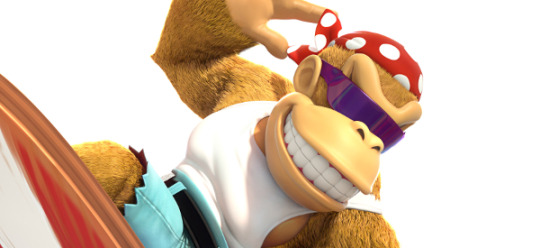
As an embodiment of one of Nintendo's most long-lived properties, and a stellar example of good dental hygiene, Funky would be an excellent addiction to the SB crew. After using his unique skills and surfboard abilities to earn his own mode in DKC: Tropical Freeze, Smash Bros. is the next obvious step.
7. Groose

Confident, burly, and well-coiffed, Groose gave Link a hard time in Skyward Sword, and I think he could present an equally tough challenge to other Nintendo characters in Smash Bros. His loftwing could probably come in handy for some special attacks, and naturally his Final Smash would be the Groosenator.
8. The Elite Beat Agents

Elite Beat Agents is one of the most underappreciated games in Nintendo history, but I think that could be remedied with an appearance in Smash Bros. I imagine that each of the agents would be represented by a different costume (although if there were a way to control all three simultaneously a la Ice Climbers that'd be amazing), and I'd love to see some sort of rhythmic element to their fighting. The Final Smash, of course, would be a full-blown musical number. Agents are GO!!!
9. Wart

Essentially forgotten since Super Mario Bros. 2, the vegetable-hating former ruler of Sub-Con deserves to make a return from the dream world and into the ranks of Nintendo's fighting elite.
10. Professor Layton
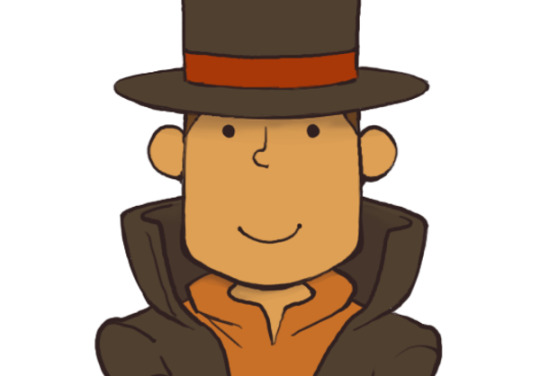
If I could add any third-party character to the Smash Bros. line-up, it would be Professor Layton. Not only have all of his games been published by Nintendo (in North America, at least), but, as a cerebrally inclined English gentleman, he stands out from other potential challengers. And given his fencing skills and penchant for makeshift weaponry (such as his coin-shooting slot machine in Professor Layton and the Unwound Future), he should have access to a variety of interesting attacks.
Bonus: Phoenix Wright

If I could add any third-party character to the Smash Bros. line-up, well, it would still be Professor Layton. But Phoenix Wright comes in a close second! Given that he's an attorney without any fighting skills of note, he might seem like an odd pick, but he did fairly well for himself in Ultimate Marvel vs. Capcom 3. That pointer finger is more dangerous than it looks.
5 notes
·
View notes
Note
Hey there. If you ever see this...you're a bad enough dude to rescue the president!

7 notes
·
View notes